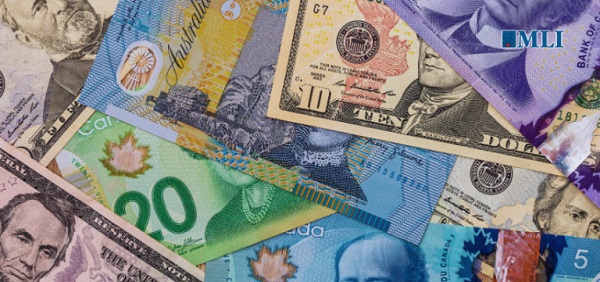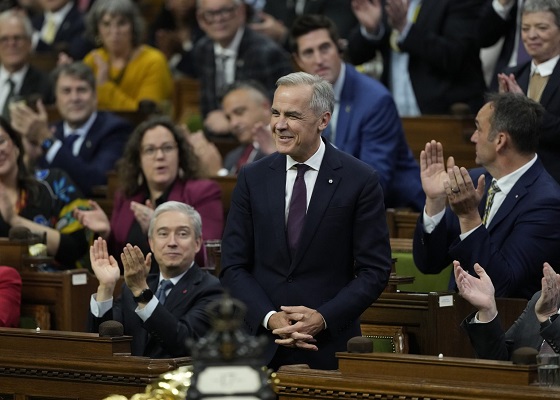Business
Canada can – and should – crack down on trade-based money laundering

From the Macdonald Laurier Institute
By Jamie Ferrill for Inside Policy
Neglecting to take decisive action enables organized criminal networks whose activities cause significant harm on our streets and those of our international partners.
Financial crime bears considerable political and economic risk. For the incoming Trump administration, the threat that transnational organized crime and the illicit financial flows pose to global financial stability is a top priority. The threat of tariffs by the Trump administration makes the costs to Canada in enabling global financial crime all too apparent. In addition to the cost of tariffs themselves, the associated reputational risk and loss of confidence in Canada’s financial system has implications for investments, credit, supply chains, and bilateral co-operation and agreements.
Canada’s proximity to major international markets, stable economy, high standard of living, and strong institutions and frameworks make it an attractive place to do business: for both legitimate and criminal enterprises.
Trade is a key contributing sector for Canada’s economic security. It represents two-thirds of Canada’s GDP, and exports alone support nearly 3.3 million Canadian jobs. Trade is also highly vulnerable to criminal exploitation. Ineffective oversight, regulatory complexity, and lagging technology adoption, coupled with a lack of export controls, make it possible to move vast proceeds of crimes, such as those from drug trafficking, human trafficking, corruption, and tax evasion through the global trade system.
These vulnerabilities are well-known by transnational organized crime groups. They are able to effectively move billions of dollars of dirty money through the global trade system every year, a method commonly referred to as Trade-Based Money Laundering (TBML).
While any statistics must be interpreted with caution, evidence shows that TBML is a prevalent method of money laundering.
What is it?
There are several types of Trade-Based Financial Crimes such as terrorism financing through trade, sanctions evasion, and simply trade fraud. However, the TBML definition is necessarily specific. Essentially here, TBML is a money laundering method: the processing of criminal proceeds to disguise their illegal origin. TBML involves the movement of value through the global trade system to obfuscate the illicit origin. This is usually done through document fraud: undervaluing, overvaluing, phantom shipping, or multiple invoicing. Different techniques employ different aspects of the supply chain. And TBML may be just one method used within larger money laundering operations.
By way of example, US authorities allege that two Chinese nationals living in Chicago laundered tens of millions of dollars for the Sinaloa and Jalisco Cartels. Drugs were smuggled into the United States and sold throughout the country. The proceeds from these sales were collected by the Chinese nationals. Those proceeds were used to purchase bulk electronics in the United States, which were then shipped – with a falsified value – to co-conspirators in China, who sold them locally. The legitimacy provided by the electronics sales and the trade transaction provide cover to “clean” proceeds from precursor crime.
Either the importer and/or the exporter of the goods can shift value. Chances here are the electronics shipped were undervalued: on leaving the country, they are declared at a (much) lower value than they are actually worth. The importer in China pays the undervalued invoice, then sells the goods for what they are worth. The profit from those electronics now appears clean, since it was used for a “legitimate” sale. The ensuing value gap can be transferred informally or stored as illicit wealth. The value has now shifted, without fiat currency leaving the country of origin.
But the cycle does not stop there. The value and money itself continue to traverse around the world, through various intermediaries such as financial institutions or cryptocurrency exchanges. It then goes right back into the system and enables the very crimes and organized crime groups that generated it in the first place. It is, in short, the business model of organized crime.
The Canadian problem
Ultimately, the proceeds of crime that have been legitimised through TBML (and other money laundering methods) supports the criminal enterprises that generated the value in the first place. In the example, these are prolific cartels who have been behind the fentanyl crisis, migrant trafficking and abuse, corruption, and widespread violence that destabilizes communities and undermines governments across North America and beyond.
With new actors, drug routes, and ways of doing business, the cartels are very much active in Canada. The Sinaloa cartel in particular has established a significant presence in Canada where it controls the cocaine market, manufactures and distributes fentanyl, and is embedded in local criminal networks. This increases Canada’s role as a strategic location for drug trafficking and a base to export abroad, notably to Europe, the US, and Australia.
Hells Angels, Red Scorpions, ’Ndrangheta, and other organized crime groups are also exploiting Canada’s strategic location using their transnational links. These groups are active in criminal activities that generate proceeds of crime, which they launder through Canadian institutions. From drug trafficking to extortion to human and sex trafficking, the foundation of organized crime relies on generating and maximizing profits. The proceeds generally need to be laundered; otherwise, there are direct lines back to the criminal organizations. They are, without a doubt, exploiting the trade sector; the very sector that provides so much economic security for Canada.
Canada’s regulation, reporting, and prosecution record for money laundering is notoriously weak. Its record for regulation, reporting, and prosecution for trade-based financial crimes, namely here TBML, is even weaker.
As financial institutions and other regulated entities face increased scrutiny following the TD Bank scandal and the Cullen Commission’s inquiry into money laundering in BC, more criminal activity is likely to be displaced into the trade sector and the institutions it comprises.
TBML is difficult for financial institutions to detect, especially given that 80 per cent of trade is done through open accounts. It exploits established trade structures that are meant to protect the system –like documentation and invoicing processes – by manipulating transactions outside traditional payment systems, which requires more sophisticated anti-money laundering strategies to address these hidden vulnerabilities.
Addressing the problem
Trade is a gaping vulnerability. Yet, it attracts minimal attention in countering transnational financial crime. Containing the fentanyl crisis for one requires a collaborative effort to bolster supply chains and the trade sector against financial crime. This means global cooperation, technological advances (such as blockchain technology), appropriate resourcing, more scrutiny on high-risk countries and shippers, and regulatory innovation.
But political will is in short supply. The federal government’s Budget 2024 and the resulting proposed Regulations Amending Certain Regulations Made Under the Proceeds of Crime (Money Laundering) and Terrorism Financing Act will grant CBSA new authorities to counter TBML, but limited resources to make good on them. And CBSA cannot do it alone.
Transnational organized crime and the illicit financial flows that support it poses a threat to global financial stability. The enabling of financial crime hurts Canada’s reputation abroad. With a new political regime emerging in the US, Canada cannot afford to be seen as a weak link. Loss of confidence in a country and its financial system has implications for investments, credit, supply chains, and bilateral cooperation and agreements.
By neglecting to take decisive action, we inadvertently enable organized criminal networks whose activities cause significant harm on our streets and those of our international partners. With profits as their primary driver, it is imperative that we scrutinize financial pathways to disrupt these illicit operations effectively.
Organized crime groups are not bound by privacy laws, bureaucracy, political agendas, and government budgets. They are continually evolving and staying many steps ahead of what Canada is equipped to control: technologically, geographically, strategically, logistically, and tactically. Without appropriate regulations, technological advances, and resources in place, we will continue to be a laggard in countering financial crime.
More systematic change is needed across regulatory frameworks, law enforcement coordination and resourcing, and international partnerships to strengthen oversight, close loopholes, and enhance detection and disruption. It would be a low-cost signal to the Trump administration that Canada is committed to upping its game.
Jamie Ferrill is senior lecturer in Financial Crime at Charles Sturt University and co-editor of Dirty Money: Financial Crime in Canada.
Business
Is affirming existing, approved projects truly the best we can do in Canada?

From Resource Works
For major projects, what is old is new again
Prime Minister Mark Carney’s second wave of “nation-building projects” sounds transformative: six new energy and mining proposals, plus a northern corridor, added to the first tranche unveiled in September, and included in the freshly passed federal budget for the fiscal year.
Together, Ottawa says, they amount to more than $116 billion in investment and are central to “realizing Canada’s full potential as an energy superpower.” That is the pitch in the federal news release.
Look closely, though, and a different picture emerges. For major projects, what is old is new again. Almost every file now being “fast-tracked” was already on the books, sometimes for a decade or more.
The new referrals to the Major Projects Office (MPO) are all familiar: the Nisga’a-led Ksi Lisims LNG terminal on B.C.’s north coast; BC Hydro’s North Coast Transmission Line; Canada Nickel’s Crawford project near Timmins; Nouveau Monde Graphite’s Matawinie mine north of Montréal; Northcliff’s Sisson tungsten project in New Brunswick; and the Inuit-owned Iqaluit Nukkiksautiit hydro project in Nunavut. The “Northwest Critical Conservation Corridor” in B.C. and the Yukon is added as a long-range concept.
Long timelines and longstanding obstacles
None of these is a fresh idea. As the Globe and Mail notes in a project-by-project rundown, Ksi Lisims has been in development for years and already faces two Federal Court challenges from nearby First Nations and opposition from Wet’suwet’en hereditary leaders who fought Coastal GasLink. The North Coast Transmission Line was identified in 2023, with B.C. legislation to fast-track it and term-sheet co-ownership deals with First Nations already in place. The Sisson mine has been stalled at the pre-construction stage for more than a decade, despite earlier approvals and new public money to update its feasibility study.
Iqaluit hydro is hardly a novelty either. As Globe reporting shows, dam concepts near the city have been studied since the mid-2000s, with the current Inuit-owned proposal building on that earlier work and backed by federal engineering funds. The Crawford nickel project was acquired in 2019 and has spent years lining up investors and a complex financing stack, documented in both CBC and Financial Post coverage. Matawinie received its Quebec authorization in 2021, has an impact-benefit agreement with the local Atikamekw Nation and now enjoys federal price-floor guarantees on graphite.
The first tranche, announced in September, follows the same pattern. LNG Canada Phase 2 in Kitimat, new nuclear at Darlington, Contrecoeur container capacity at the Port of Montréal, McIlvenna Bay in Saskatchewan and the Red Chris expansion in B.C. were all in various stages of planning long before Carney entered office. The MPO is not inventing a new project pipeline; it is trying to accelerate the one Ottawa already had.
Acceleration is the point — and industry welcomes it
Acceleration is, to be fair, the point. The Calgary-based MPO, led by former Trans Mountain head Dawn Farrell, is designed to run permits in parallel, not one after another, and to coordinate financing through bodies like the Canada Infrastructure Bank and Canada Growth Fund. Farrell told CBC that work which might have taken “five or six more years” could be cut to roughly two. In a country where large projects regularly die of regulatory exhaustion, that is significant.
Industry likes the signal. Canada Nickel CEO Mark Selby says MPO referral “puts us in the fast lane,” even without the more controversial “national interest” label in Bill C-5 that would allow cabinet to set aside parts of the Fisheries Act, Species at Risk Act or Impact Assessment Act. Inuit proponents of the Iqaluit project welcome Carney’s description of their hydro plan as a breakthrough for Arctic sovereignty, replacing millions of litres of diesel.
But a superpower strategy this is not
Still, if this is what becoming an “energy superpower” looks like, it is a modest start.
Notably absent from Carney’s list is any new oil pipeline. Alberta Premier Danielle Smith has spent months pushing a concept for a bitumen pipeline from the oil sands to the northern B.C. coast, doing provincial groundwork in the hope a private proponent will one day take it over. A BBC report sets out the feud with B.C. Premier David Eby, who dismisses the idea as “fictional” and “political” and insists no company wants it, accusing Smith of jeopardizing B.C.’s LNG ambitions. Smith has called that stance “un-Canadian.”
Western frustration is growing. In the National Post, Whitecap Resources chief executive Grant Fagerheim warns of “fury from Alberta and Saskatchewan” if a pipeline to tidewater is never prioritized and argues producers are tired of a U.S.-dominated system where Canadian barrels sell at a discount while others capture the margins. He favours an energy corridor carrying oil, gas, power and rail, not just more rhetoric about nation-building.
Northern ambitions lag behind rhetoric
Another gap is the North. The Indigenous-led Arctic Gateway partnership, Manitoba and Ottawa are already spending heavily on the Hudson Bay Railway and planning new storage and loading systems to expand the Port of Churchill for grain, potash, critical minerals and Arctic resupply. Carney talks up a “huge host of opportunities” in northern Manitoba, but Churchill sits only on the MPO’s lower-profile “transformative strategies” list, with a full plan now pushed out to 2026.
Meanwhile, the one project that has fundamentally shifted Canada’s oil export position is the long-delayed Trans Mountain expansion. As Resource Works points out, TMX now sends diluted bitumen from Burnaby to Asia, shrinking the old “captive discount” and giving Canada genuine leverage in global markets. But TMX predates Carney’s government by more than a decade and only exists because Ottawa nationalized a struggling private pipeline to get it built.
Evolution, not revolution
Carney’s major-projects push is real, and for the companies involved, the prospect of faster permits and clearer federal backing is very good news. Yet for a government that talks about mobilizing a trillion dollars and remaking Canada as an energy superpower, the current list is evolutionary rather than revolutionary. For now, Ottawa is mostly trying to build what was already on the drawing board. The tougher choices on pipelines, ports and interprovincial trade still lie in front of it.
Headline photo credit to THE CANADIAN PRESS/Adrian Wyld
Business
Taxpayers paying wages and benefits for 30% of all jobs created over the last 10 years

From the Fraser Institute
By Jason Childs
From 2015 to 2024, the government sector in Canada—including federal, provincial and municipal—added 950,000 jobs, which accounted for roughly 30 per cent of total employment growth in the country, finds a new study published today by the Fraser Institute, an independent, non-partisan Canadian public policy think-tank.
“In Canada, employment in the government sector has skyrocketed over the last 10 years,” said Jason Childs, a professor of economics at the University of Regina, senior fellow at the Fraser Institute and author of Examining the Growth of Public-Sector Employment Since 2015.
Over the same 10-year period (2015-2024), government-sector employment grew at an annual average rate of 2.7 per cent compared to only 1.7 per cent for the private sector. The study also examines employment growth by province. Government employment (federal, provincial, municipal) grew at a higher annual rate than the private sector in every province except Manitoba over the 10-year period.
The largest gaps between government-sector employment growth compared to the private sector were in Newfoundland and Labrador, New Brunswick, Quebec and British Columbia. The smallest gaps were in Alberta and Prince Edward Island.
“The larger government’s share of employment, the greater the ultimate burden on taxpayers to support government workers—government does not pay for itself,” Childs said.
A related study (Measuring the Cost to Canadians from the Growth in Public Administration, also authored by Childs) finds that, from 2015 to 2024, across all levels of government in Canada, the number of public administrators (many of who
work in government ministries, agencies and other offices that do not directly provide services to the public) grew by more than 328,000—or 3.5 per cent annually (on average).
“If governments want to reduce costs, they should look closely at the size of their public administration,” Childs said.
Examining the Growth of Public Sector Employment Since 2015
-

 Crime2 days ago
Crime2 days ago‘Modern-Day Escobar’: U.S. Says Former Canadian Olympian Ran Cocaine Pipeline with Cartel Protection and a Corrupt Toronto Lawyer
-

 Health2 days ago
Health2 days agoCDC’s Autism Reversal: Inside the Collapse of a 25‑Year Public Health Narrative
-

 Crime2 days ago
Crime2 days agoCocaine, Manhunts, and Murder: Canadian Cartel Kingpin Prosecuted In US
-

 Health2 days ago
Health2 days agoBREAKING: CDC quietly rewrites its vaccine–autism guidance
-

 Alberta23 hours ago
Alberta23 hours agoPremier Smith explains how private clinics will be introduced in Alberta
-

 Health2 days ago
Health2 days agoTens of thousands are dying on waiting lists following decades of media reluctance to debate healthcare
-

 Opinion2 days ago
Opinion2 days agoLandmark 2025 Study Says Near-Death Experiences Can’t Be Explained Away
-

 Focal Points2 days ago
Focal Points2 days agoSTUDY: TikTok, Instagram, and YouTube Shorts Induce Measurable “Brain Rot”








